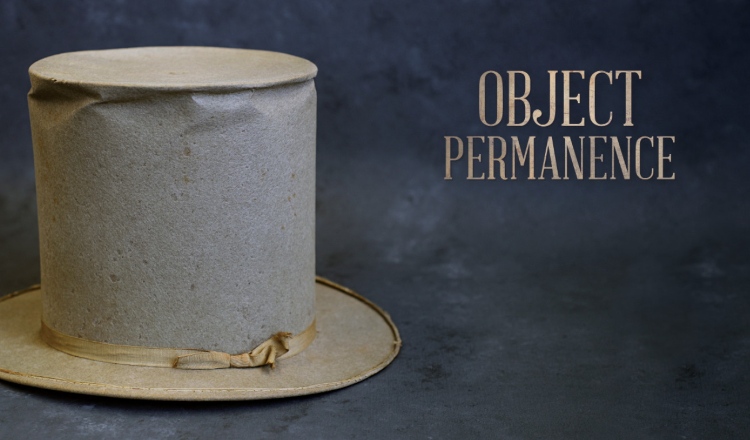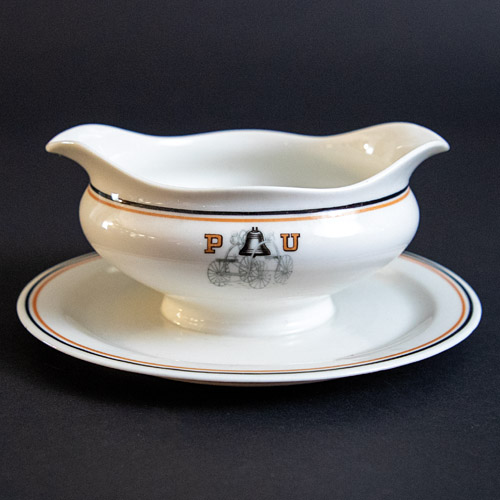
141. Victory Bell Gravy Boat
At one time, each residence hall had a custom china set used for special occasions. One set was purchased by John Purdue in New York City as a gift for a friend’s wedding. The family later donated the set to the University.
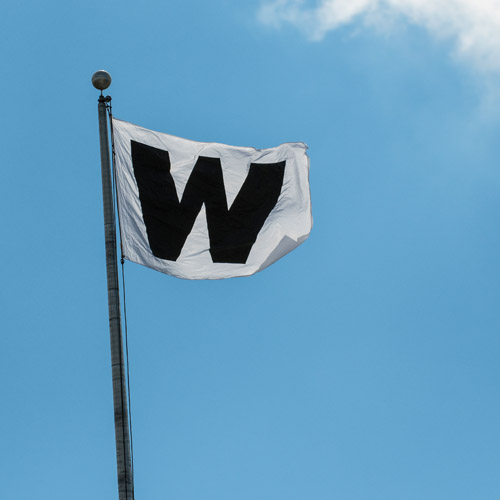
142. W Flag
It was lifelong Chicago Cubs fan Dale Samuels (HHS’63) who suggested Purdue take a page from the Wrigley Field playbook and begin hoisting a W flag after home wins. A member of the Cradle of Quarterbacks, Samuels recalls the first time the W flag was raised over Ross-Ade Stadium after the Boilermakers pummeled nationally ranked California 41–14 in the home opener in 1992. The W flag has flown over Ross-Ade next to the American flag and Purdue flag after every home victory since.
The W flag flies above Ross-Ade Stadium after every home football victory.
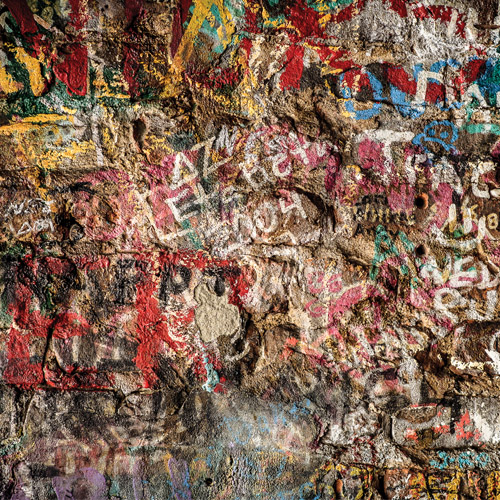
143. The Wall at Harry’s
Harry Marack (-A’23) opened Harry’s Chocolate Shop as a soda fountain in 1919 on the corner of State and Pierce Streets, where it stands today. Harry’s started serving beer in the 1930s and remained in the Marack family until it was sold to current owners Herschel and Mary Cook in 1977. The bar’s slogan, Go Ugly Early, is reported to be a play on the antonyms for “come pretty late.” Although it’s rumored that Harry’s was a speakeasy during prohibition, that claim has never been substantiated. No doubt the iconic campus bar has seen questionable activities over the past century. Its walls, covered with patrons’ colorful scrawls, serve as part registry and part diary. If only those walls could talk.
Go Ugly Early at Harry’s Chocolate Shop
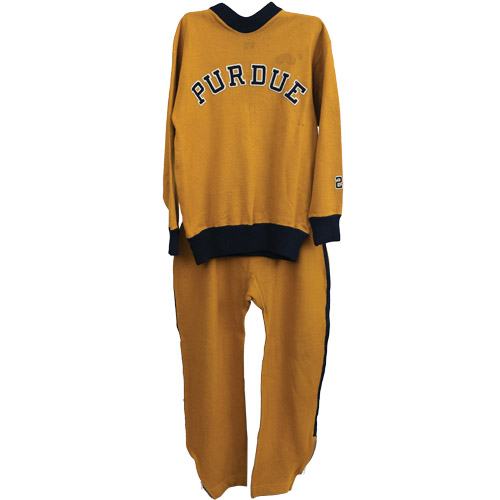
144. Warm-Up Suit
On September 12, 1936, tragedy struck Purdue’s football team when a locker room explosion took the lives of two players: veteran guard Carl Dahlbeck, 25, and halfback Tommy McGannon, 20. The blast and subsequent fire started when a thin layer of gasoline accumulating on top of rising water in the shower room reached a small heating stove, thanks to a clogged shower drain. At that time, it was common practice for players to use gasoline to dissolve the adhesive left behind by athletic tape on their bodies. Lowell Decker (S’38) and several others suffered severe burns when they fell in the fiery water during the scramble to escape. Somehow, the injured managed to jump into the Ross Camp pool adjacent to the shower facility. This astoundingly mustard warm-up suit belonged to Decker, who recovered from his injuries and returned to the lineup the following season.
It is part of the permanent collection of the Tippecanoe County Historical Association.
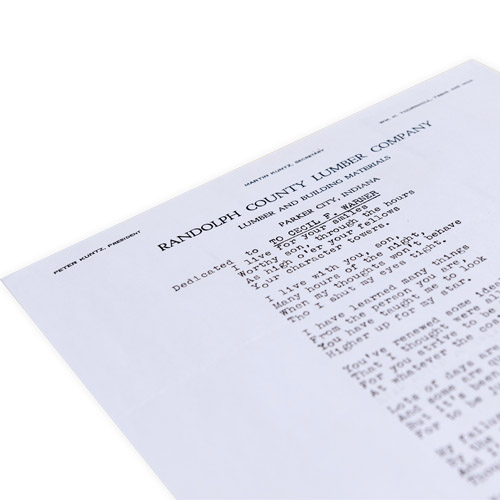
145. Warner Poem
Clyde Warner wrote a poem for his son, Cecil F. Warner (ME’39, PhD ME’45), on letterhead of the lumber company where the elder Warner worked as yard manager and bookkeeper. It includes the stanza: “Lots of days are not sunny; And some are quite bad, But it’s been worth the living; For to be just your dad.” A poignant sentiment from a father who worked 11-hour days, six days a week to support his family and send his son to college. Cecil Warner retired in 1981 after nearly 40 years as a professor of mechanical engineering. He was instrumental in developing the Purdue Jet Propulsion Laboratory and pioneered research in liquid-fueled rocket engines.
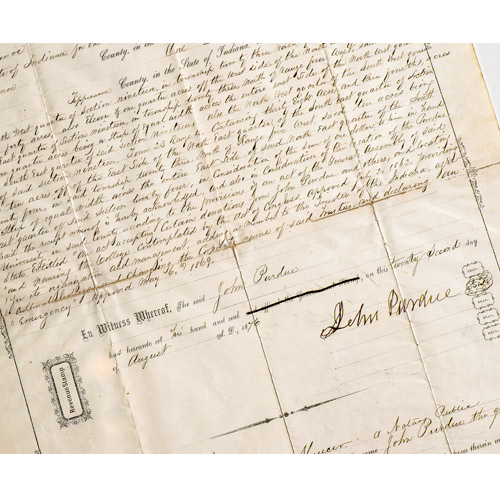
Courtesy of the Virginia Kelly Karnes Archives and Special Collections Research Center, Purdue University Libraries
146. Warranty Deed
In bidding for the state of Indiana to build its land-grant university in Tippecanoe County, John Purdue sweetened the deal with a promise of 100 acres of land for the new college, in addition to his financial gift of $150,000. He did not specify it would be his land — it was not — and he did not specify he alone would purchase it. The land was acquired by an unknown group of individuals who had a financial interest in the school being located on the west bank of the Wabash River. With this document, signed August 22, 1876, Purdue, who died without a will, finally deeded that land, which he had personally held for seven years, to the state. Purdue died three weeks later on September 12, and it’s possible he had not yet even given the warranty deed to the university board of trustees. The morning after Purdue’s death, administrators and business leaders scurried to the courthouse to make the deed official. There might have been concern that Purdue’s surviving relatives would claim the land as theirs.
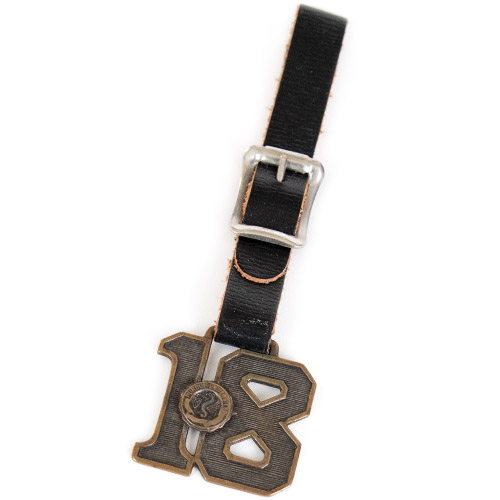
147. Watch Fob
Pocket watches were often attached to fobs — straps of leather that made an object easier to handle — and carried in the front fob pocket of a vest or waistcoat. Toward the end of the 19th century, the free end of a leather watch fob was often decorated with a metallic medallion or seal and allowed to hang out of the fob pocket as a display of status or group affiliation. In many formal photographs from the later 1800s through World War I, when wristwatches began to replace pocket watches, the watch fob is prominently displayed in the photo. A Purdue man was not fully dressed unless he had his watch fob displayed to show his level of sophistication and his affiliation with his class year or fraternal organization.
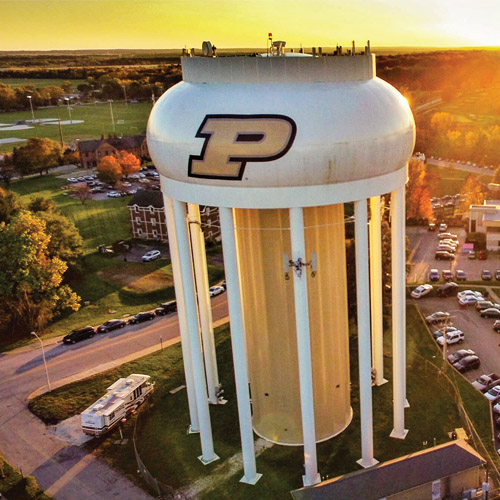
148. Water Tower
For decades, the campus water tower was the scourge of the West Lafayette skyline. At 142 feet tall, the tower was originally painted red and white to comply with FAA regulations. Finally, in 2001, the FAA made an exception, granting the University permission to repaint the water tower with the school’s logo and colors.
See the Purdue Water Tower for yourself.
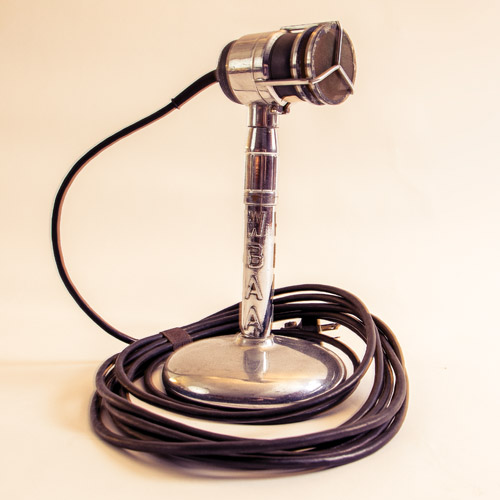
149. WBAA Microphone
WBAA, the oldest continuously operating radio station in Indiana, was licensed in 1922. Its first broadcast covered Arbor Day and aired at 9:00 p.m. on April 21, 1922. Then housed in the Electrical Engineering Building, the station moved to studios in the newly opened Hall of Music in 1940.
This microphone is on display in the Spurgeon Hall of Spirit at Dauch Alumni Center.
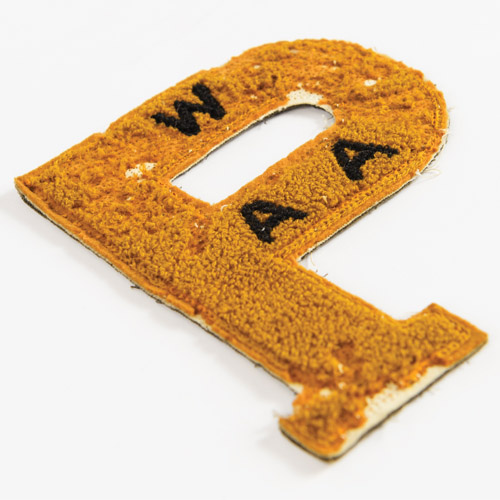
Courtesy of the Virginia Kelly Karnes Archives and Special Collections Research Center, Purdue University Libraries
150. Women’s Athletic Association Patch
From the collection of Rosemary Anne Murphy (S’29), one of Purdue’s first prominent women athletes. During her undergraduate years, she played soccer, basketball, and baseball and participated in coed track meets, although women had no intercollegiate competition at that time. In 1927, Murphy became the president of the Women’s Athletic Association. She traveled to New York to represent the University at the Athletic Conference of American College Women.

